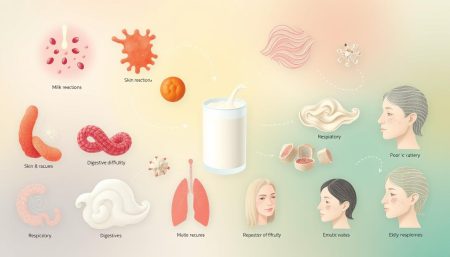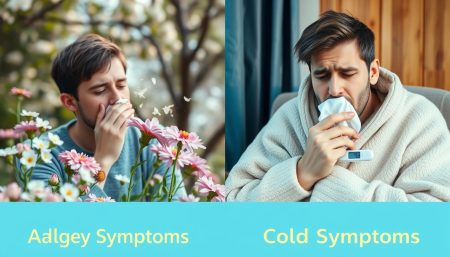Many people cherish the love of a furry friend. But, it’s important to know the signs of dog allergies for those who suffer. This guide aims to help you spot dog allergy symptoms and understand their effects.
Dog allergies can show up in many ways. Being alert to early warning signals can improve your life and your bond with dogs. As you learn about dog allergy symptoms, remember you’re not alone.
Key Takeaways
- Understanding the various warning signs is the first step toward managing dog allergies.
- Knowledge of dog allergy symptoms empowers affected individuals to take timely action.
- Identifying both overt and subtle signs of dog allergies is crucial for maintaining wellbeing.
- Distinctly recognizing dog allergy symptoms can deepen the bond between pets and their humans while managing health challenges.
- Seeking professional guidance is advised if dog allergy symptoms are affecting day-to-day life.
Understanding Dog Allergy Symptoms
When we talk about allergic reactions to dogs, it’s key to know the wide range of symptoms of dog allergies. We’ll share medical insights and practical tips. This will help you understand and manage your allergies.
Defining Allergic Reactions in Dogs
Allergic reactions to dogs happen when a person’s immune system reacts badly to proteins in a dog’s dander, saliva, or urine. These reactions can be mild, like skin irritation, or severe, like breathing problems.
Common Misconceptions About Dog Allergies
Many think only some dog breeds are hypoallergenic and safe for people with allergies. But, all dogs have allergens, even if some breeds have less.
Can Any Dog Breed Cause Allergies?
Yes, any dog breed can cause allergies because all dogs have dander and proteins that can trigger allergic reactions. The idea of hypoallergenic breeds is misleading. It means they usually have fewer allergens, not none.
This knowledge is vital for managing dog allergies. It helps you choose the right breed and control your environment at home.
To show how different dog breeds are in allergen production, look at this table. It compares the allergen levels in popular breeds:
| Dog Breed | Allergen Level |
|---|---|
| Labrador Retriever | High |
| Poodle | Low |
| German Shepherd | Medium |
| Siberian Husky | Medium |
| Maltese | Low |
Knowing these differences helps in managing dog allergies. It also helps people choose a breed that fits their health needs.
Top Signs of Dog Allergies You Shouldn’t Ignore
It’s important to know the warning signs of dog allergies to stay healthy. This part will show you key signs that might mean you have a pet allergy.
- Sneezing and Nasal Congestion: These are often the first pet allergy symptoms. If you keep sneezing and have a runny or stuffy nose, it’s a sign.
- Red, Itchy Eyes: This symptom is common and can also be accompanied by watering which exacerbates discomfort.
- Itchy Skin or Hives: Appearing as red patches on the skin, these are tell-tale dog allergy symptoms. The urge to scratch frequently could point to an allergic reaction.
- Coughing or Wheezing: These respiratory symptoms are significant, especially if they occur frequently in the presence of a dog.
There are also more subtle pet allergy symptoms that might go unnoticed:
| Symptom | Relevance to Allergies |
|---|---|
| Post-Nasal Drip | Excess mucus feel that can lead to throat clearing |
| Fatigue | Often overlooked, but allergic reactions can disrupt sleep and lead to fatigue |
| Chest Tightness | Can be a severe symptom requiring immediate medical attention |
A guardian noticed her child’s frequent coughing and eye rubbing whenever their puppy was around. After a medical consultation, they confirmed it was due to dog allergy symptoms, leading to important lifestyle adjustments.
By familiarizing with these warning signs of dog allergies, individuals can take proactive steps towards diagnosis and management, ensuring both their well-being and that of their pets.

Identifying Different Types of Allergic Reactions to Dogs
Living with or around dogs means knowing about different allergic reactions. The body reacts differently to allergens like dog dander. It’s important to understand the types of reactions and how they show up.
Immediate vs. Delayed Reactions
An immediate allergic response to dogs happens fast, within minutes to hours. Symptoms like sneezing, wheezing, or skin hives are common. On the other hand, delayed reactions might take hours or days to show up. This makes them harder to link to the allergen.
The Role of Dog Dander in Allergies
Dog dander is made up of tiny skin flecks from dogs. These flecks often carry proteins that cause allergies. Knowing how dog dander works is key for managing or diagnosing allergies.
Navigating Symptoms of Dog Allergies
Many people love having pets but face unexpected allergic reactions. Spotting dog allergy symptoms early helps manage them well. This guide helps you detect and tackle these symptoms, making your home safe for you and your pet.
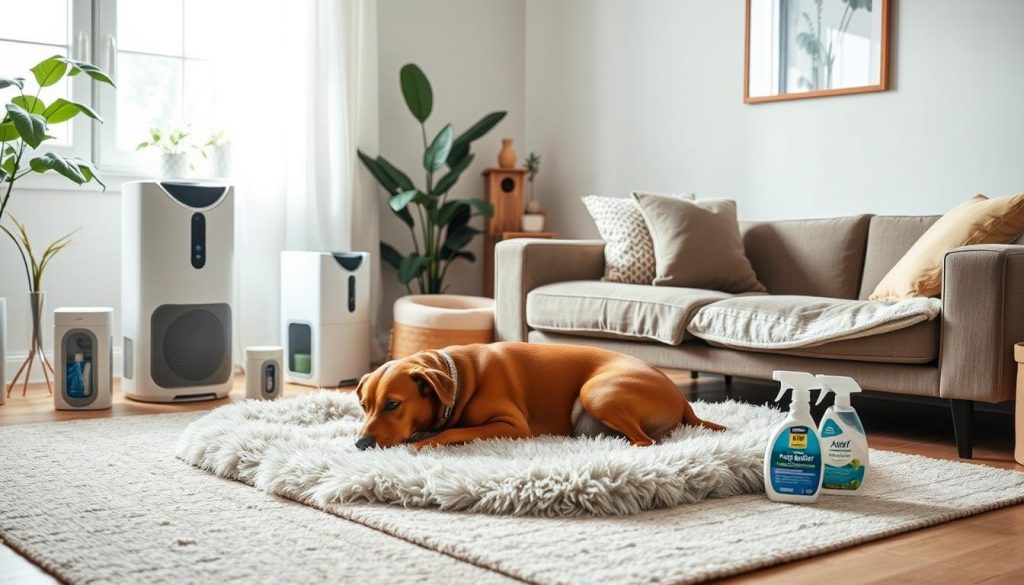
Starting to manage dog allergies means knowing the common signs. These include sneezing, stuffy nose, itchy eyes, or skin rashes. Each symptom can be mild or severe, needing different care.
- Regular cleaning helps cut down on allergens at home
- High-efficiency particulate air (HEPA) filters are a good choice
- Setting up pet-free areas in your home is wise
- Anti-allergen sprays or solutions on pet bedding and furniture help
Real-life stories from people who’ve managed their allergies can be very helpful. For example, someone might talk about how hypoallergenic bedding improved their sleep. It shows how simple changes can make a big difference.
This dog allergy symptoms guide also stresses the need to see a doctor. They can create a plan that fits your needs. Since everyone’s allergies are different, a custom plan is best.
With the right steps, living with a pet and allergies can be rewarding. It’s all about finding a balance that makes life better for both you and your pet.
Skin-Related Dog Allergy Symptoms
When it comes to allergies related to pets, especially dogs, the skin often gets affected. Skin reactions to dogs can range from mild irritations to severe conditions like eczema. This shows how different people’s bodies can react to allergens.
We will look at different skin symptoms caused by pet allergies. These include rashes, hives, and eczema.
Rashes and Hives Explained
Rashes from dog allergies appear as red, itchy patches on the skin. They usually show up after direct contact with a dog or its dander. These rashes are a clear sign of an allergic reaction and can cause a lot of discomfort.
Hives, on the other hand, are raised and intensely itchy welts. They can occur anywhere on the body. They can show up within minutes of exposure to an allergen, like pet dander. This makes them a quick sign of dog allergies.
Eczema as a Sign of Pet Allergy
Eczema and pet allergies are closely linked. Eczema is a more persistent condition with dry, flaky, and itchy skin. For those sensitive to pet dander, regular exposure can make this condition worse, leading to ongoing irritation and discomfort.
Here’s a comparison of rashes caused by dog allergies and eczema triggered by pet dander:
| Condition | Appearance | Primary Trigger | Common Areas Affected |
|---|---|---|---|
| Rashes from Dog Allergies | Red, patchy, itchy | Direct contact with pet dander | Arms, neck, face |
| Eczema from Pet Allergies | Dry, rough, inflamed | Continuous exposure to pet dander | Hands, neck, facial regions |
It’s important to identify and understand these skin reactions to dogs. Whether it’s rashes from dog allergies or eczema caused by pet dander, taking preventive measures and seeking the right treatments can help ease the discomfort.
Respiratory Symptoms from Pet Allergies
Many people with pet allergies find that dogs can cause big problems. Knowing about these symptoms helps manage allergies better.
Signs like wheezing, coughing, and feeling out of breath are common. Severe cases can lead to asthma attacks, which are emergencies. Spotting these signs early is key to staying healthy and dealing with pet allergies and breathing issues.

The table below lists typical respiratory symptoms from dog allergies. It also shows how serious they can be:
| Symptom | Description | Severity |
|---|---|---|
| Wheezing | A high-pitched sound during breathing, often indicating obstruction or constriction of the airways. | Moderate to Severe |
| Shortness of Breath | Difficulty breathing normally, feeling as if you can’t get enough air; | Moderate |
| Asthma-like Symptoms | Includes episodes of severe wheezing, chest tightness, and coughing, especially at night or early morning. | Severe |
If you’re experiencing these symptoms, see a doctor who knows about allergies. Getting help early is important for relief and to avoid bigger problems with respiratory dog allergy symptoms.
Eyes and Nose: Recognizing Allergic Reactions
Looking into allergic reactions to dogs shows us how common and upsetting they can be. Focusing on the eyes and nose helps us understand the daily struggles of people with pet allergies. Early action can make life better and reduce discomfort.
Managing Itchy and Watery Eyes
One clear sign of itchy eyes from pet allergies is the constant need to rub them. This is because the body is trying to get rid of allergens. But rubbing can make things worse and even lead to infections if not handled right.
- Use anti-allergen eye drops approved by healthcare providers.
- Implementing frequent hand washing to prevent transferring allergens to the eyes.
- Applying a clean, damp cloth to the eyes can help reduce irritation.
Addressing Nasal Congestion and Sneezing
Dealing with nasal allergy symptoms like sneezing and stuffy nose can really get in the way. These signs are the body’s way of trying to get rid of irritants.
- Maintaining a clean environment to minimize the presence of dog dander and other allergens.
- Using over-the-counter nasal sprays that can help in reducing inflammation and congestion.
- Consulting with an allergist for tailored treatment options may be necessary for severe cases.
“Dog Allergy Symptoms”: How the Body Reacts
Some people react to dogs with allergic symptoms. But what happens inside the body? This part explores the body’s reaction to dog allergies. It looks at the immune system and allergies and how histamines play a part.
The Immune System’s Response to Allergens
When the body meets dog allergens, it sees them as dangers. It makes antibodies to fight them. These antibodies release chemicals, including histamine. This is key to understanding dog allergy reactions.
Understanding Histamines and Their Effects
Histamines are key in allergic reactions. They make blood vessels wider and muscles tighter. This leads to itching, swelling, and redness, common symptoms of dog allergies. Knowing about these effects helps us understand the discomfort of dog allergies.
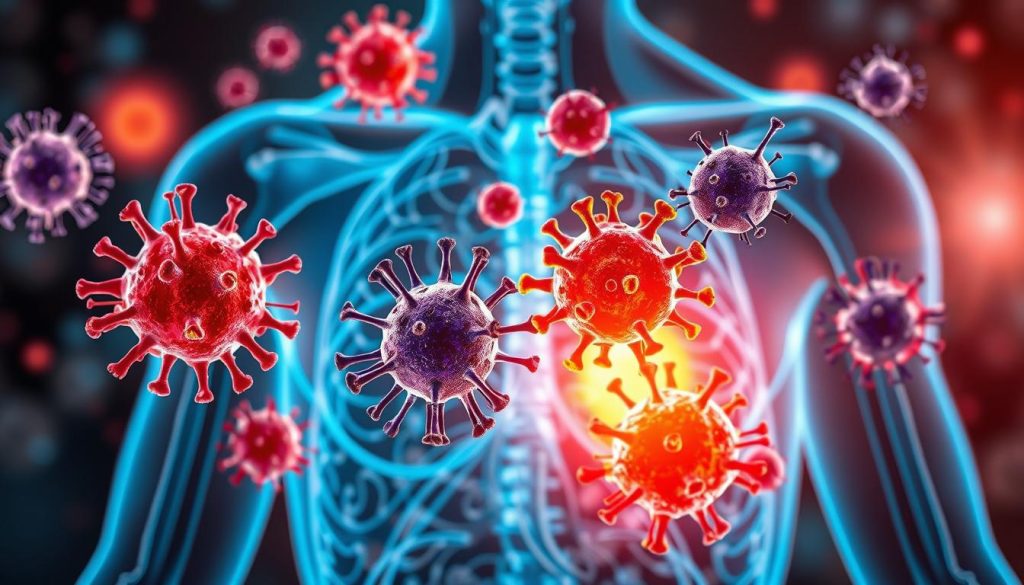
It’s important to quickly recognize and manage these reactions. This helps reduce discomfort and improves life quality.
Gastrointestinal Signs of Dog Allergies
While often overshadowed by respiratory or skin symptoms, gastrointestinal symptoms of pet allergies are significant indicators that should not be neglected. Disturbances in digestion can signal dog allergies and digestive issues, emphasizing the broader impact allergies can have on overall health.
Individuals observing their pets closely might notice signs that are commonly associated with digestive discomfort due to allergies. Recognizing these signals early can facilitate timely intervention and management.
- Vomiting or regurgitation
- Diarrhea, often with urgency
- Excessive flatulence
- Abdominal pain or bloating
This array of dog allergies and digestive issues necessitates a deeper understanding and awareness among pet owners. Awareness is vital for managing these symptoms effectively, avoiding worsening of conditions, or mismanagement of an underlying allergy.
| Symptoms | Associated Allergic Reactions | Common Dog Allergens |
|---|---|---|
| Vomiting | Digestive system reaction to allergens | Food proteins, additives |
| Diarrhea | Immediate gastrointestinal response | Dander, diet-related |
| Flatulence | Gut flora imbalance | Grains, commercial food fillers |
| Abdominal pain | Inflammatory response to allergens | Chemical sensitivities, preservatives |
The complexity and interrelated nature of gastrointestinal symptoms of pet allergies highlight the need for comprehensive allergy testing and tailored dietary management to alleviate and prevent such symptoms from escalating. It’s crucial for pet owners to consult with veterinarians who can provide insights and strategies specifically designed to combat gastrointestinal signs of dog allergies.
Severe Allergic Reactions: Anaphylaxis Awareness
Anaphylaxis from dog allergies is a serious emergency that can happen without warning. It’s important to know the symptoms and how to act fast. This is key for anyone who might be exposed to dog allergens.
Recognizing Anaphylactic Shock
Anaphylactic shock from dog allergens is a quick and severe reaction. It needs immediate help. Symptoms include trouble breathing, a sudden drop in blood pressure, and skin issues like hives.
Swelling of the throat and feeling like your chest is tight are also signs. These point to anaphylaxis from dog allergies.
Emergency Treatment for Severe Reactions
Quick action is crucial when facing severe allergic reactions. Starting emergency allergy treatment is vital. This usually means using an epinephrine auto-injector.
After that, getting professional medical help is key to fully manage the reaction. People at risk should carry an emergency allergy kit. This kit should include prescribed epinephrine auto-injectors.
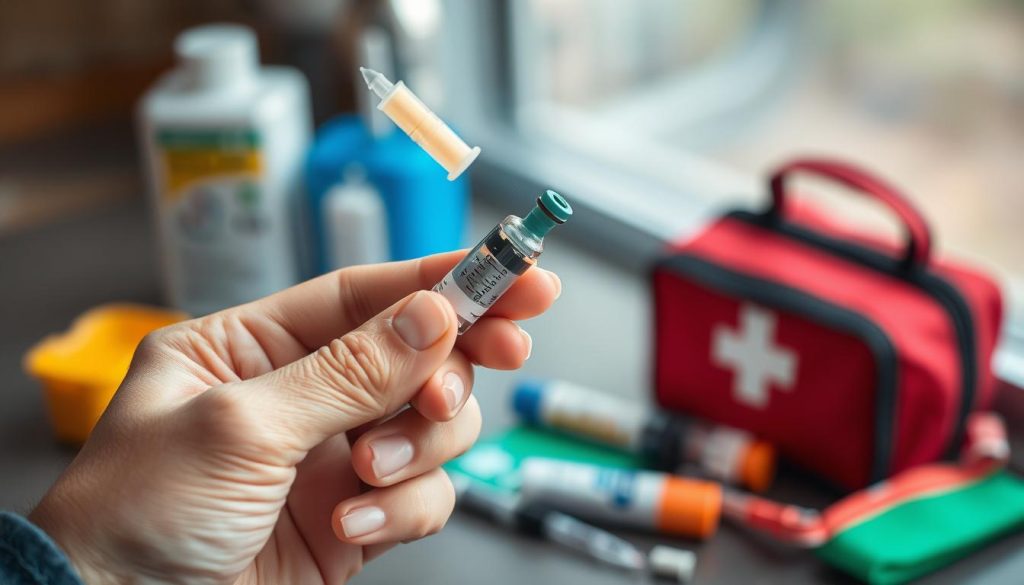
| Sign | Action |
|---|---|
| Difficulty Breathing | Use epinephrine auto-injector immediately |
| Skin Hives | Administer antihistamines post epinephrine, if approved by a healthcare provider |
| Swelling of Throat | Call emergency services without delay |
| Dizziness or Fainting | Lie down with legs elevated to stabilize blood pressure |
When to See a Doctor: Dog Allergy Symptoms
Knowing when to get medical help for dog allergy symptoms is crucial. If home remedies don’t work, or symptoms get worse, see a doctor. Knowing who to talk to and what to expect can make things easier.
Deciding to Consult an Allergist
Seeing an allergist is a big step in managing allergies. They specialize in allergies and asthma. If you keep sneezing, have itchy eyes, or trouble breathing after being around dogs, an allergist can help.
They offer treatments that regular doctors might not. This can make a big difference in how you feel.
Testing and Diagnosis for Dog Allergies
Diagnosing dog allergies starts with a detailed medical history and physical check-up. Allergists might do skin prick tests or blood tests to find out what you’re allergic to. These tests help find the exact cause of your allergies.
In a skin prick test, a small amount of the allergen is put on your skin and lightly scratched. If a wheal appears, it means you’re allergic. Blood tests measure the amount of allergy-causing antibodies in your blood.
Understanding your test results helps your allergist create a treatment plan. This plan might include avoiding certain things, taking medicine, or immunotherapy. Getting a proper diagnosis is the first step to managing your allergies and improving your life.
Managing Dog Allergies: Lifestyle Changes That Help
Living with dog allergies can be tough. But, making some dog allergy lifestyle adjustments can really help. This section will show you how to change your home and habits to fight allergies better.
Start by cleaning your home well. Vacuuming floors, carpets, and furniture with HEPA filters catches dog dander. Hard floors instead of carpets also help keep dander down.
Limit your dog’s space in the house too. Make some areas “dog-free” where you sleep or hang out. Use allergen-resistant bedding and wash bed linens in hot water to get rid of dander.
How you groom your dog is also key. Bathing your dog weekly cuts down on allergens at home. Brushing them outside keeps fur and dander out of the house.
- From the Experts: Allergy doctors say air purifiers help catch dander and allergens in the air.
- Dietary Considerations: Adding omega-3 fatty acids to your dog’s food might make their skin healthier and reduce dander.
Changing your daily habits and what you eat helps you and your family. It makes your home a better place for everyone.
- Avoid heavy fabrics like drapes and furniture that hold onto allergens.
- Use washable throw rugs for easy cleaning.
- Maintain a good humidity level to stop dander from spreading in the air.
By making lifestyle changes, you can manage dog allergies better. This makes your home healthier and improves life for those with allergies.
Dog Allergy Relief: Over-the-Counter Solutions
Many people love having dogs, but allergies can make it hard. Luckily, there are over-the-counter options like antihistamines and nasal sprays. These can quickly ease allergy symptoms and are easy to find.
Antihistamines and Their Effectiveness
Antihistamines are a common first choice for pet allergy symptoms. They stop histamines, which cause itching and swelling. While they don’t cure allergies, they can make life with pets much better.
Nasal Sprays and Decongestants
Nasal sprays with decongestants help with breathing and congestion. They reduce swelling in the nose, making it easier to breathe. But, it’s important to use them as directed to avoid side effects.
Knowing how to use these remedies right can help manage dog allergies. It’s all about making informed choices for better health.
Long-Term Dog Allergy Treatment Options
For those with chronic dog allergies, finding lasting dog allergy treatment options is key. Many turn to immunotherapy for allergies or alternative dog allergy remedies to ease symptoms. We’ll look into these options and their benefits for long-term relief.
Immunotherapy and Allergy Shots
Immunotherapy, or allergy shots, is a main treatment for severe dog allergies. It makes the immune system less reactive to allergens like pet dander. This is done by giving more of the allergen over time.
Many see big improvements in symptoms within a year. But, treatment can last several years. Talking to an allergist can help decide if it’s right for you. Comprehensive evaluations and testing can also make the treatment fit your needs better.
Alternative Remedies for Allergy Sufferers
Some people try herbal supplements, probiotics, and diet changes to help their symptoms. These options might seem gentler. But, it’s important to check their safety and effectiveness before starting.
Keeping a clean home, using HEPA filters, and regular pet grooming also help. These habits can lessen allergy symptoms and improve life quality.
Exploring dog allergy treatment options long-term requires working with healthcare providers. They can help find the best balance between managing symptoms and treatment risks. Immunotherapy for allergies and alternative dog allergy remedies offer hope for those wanting to live comfortably with pets.
Dog Breeds for Allergy Sufferers: Are There Hypoallergenic Options?
Choosing a dog for someone with allergies is a big decision. The term ‘hypoallergenic dog breeds’ is often used, hoping to lessen allergic reactions. But, it’s key to know that no dog is completely hypoallergenic. Still, some breeds might cause fewer allergies than others.
Dander, found in pet hair, is the main cause of allergies. Some dog breeds shed less and produce less dander. This makes them good choices for those with allergies.
- Poodle (Standard, Miniature, and Toy)
- Bichon Frise
- Portuguese Water Dog
- Schnauzer (Miniature and Standard)
- Maltese
Even though these breeds might cause fewer allergies, it’s crucial to meet the dog first. Allergic reactions can differ from person to person. Meeting the dog can help figure out if it causes any symptoms.
Choosing a dog for someone with allergies is more than just the breed. The dog’s health, coat, and living environment are also important. Keeping the dog clean and the home tidy can also help reduce allergens.
In short, while hypoallergenic dog breeds offer hope, doing your research and meeting the dog is key. Talking to allergists and vets can also give you personalized advice.
Maintaining a Pet-Friendly Home: Reducing Allergens
For pet owners with allergies, keeping a clean home is as important as vet visits. By using pet-friendly cleaning and good pet hygiene, you can cut down dog allergens at home. This guide will share cleaning tips and why regular dog grooming is key for allergy prevention.
Cleaning Tips to Minimize Allergens
To make your home pet-friendly and low on allergens, start with regular, deep cleaning. Good pet-friendly cleaning is more than just sweeping now and then. Here are some tips:
- Use HEPA filters in your vacuum cleaners and air purifiers to trap pet dander and other allergens.
- Regularly wash bedding, including your pet’s, in hot water to kill allergens.
- Opt for easy-to-clean surfaces such as leather or specially designed pet-friendly fabrics for furniture.
- Keep pets out of certain areas, especially bedrooms, to create allergen-free zones.
Importance of Grooming and Pet Hygiene
Regular grooming is key for your pet’s health and to cut down on allergens they spread. Grooming practices can greatly reduce pet dander and other allergens:
- Bathe your dogs regularly using hypoallergenic shampoos recommended by veterinarians.
- Brush your pet’s coat frequently to remove dander and loose hair before it spreads indoors.
- Schedule regular professional grooming sessions, especially for long-haired breeds more prone to shedding.
- Clean and disinfect pet areas and items, such as crates, toys, and food bowls, to prevent allergen accumulation.
Here’s a helpful guide to managing cleanliness in a home with pets:
| Action | Frequency | Benefits |
|---|---|---|
| Vacuuming with HEPA Filter | Twice a week | Removes dander and fur from carpets and upholstered surfaces |
| Washing Pet Bedding | Weekly | Helps eliminate accumulated dander and odors |
| Dog Grooming | Every 4-6 weeks | Keeps fur manageable and reduces the amount of allergens |
| Restrict Pet Access | Ongoing | Limits dander spread to key areas like bedrooms |
Conclusion
This guide has covered a lot about understanding dog allergies. We’ve looked at how to spot the first signs and deal with serious reactions. It’s key to know the signs of a dog allergy, as they can show up in many ways.
These signs include skin problems, breathing issues, and eye troubles. It’s crucial to manage these allergies well. This is for the health of people and the happiness of pets.
Dog allergy management needs a custom plan. This might include medicine or changing the environment. Cleaning and grooming are important steps.
While managing allergies is complex, the right steps can make life better. You can live well with your dog.
Now, our readers have useful tips and support for understanding dog allergies. We hope this article helps you and your pets. It’s our wish for a happy, allergy-free life together.
FAQ
Q: What are common symptoms of dog allergies?
A: Symptoms include sneezing and a runny nose. You might also have itchy eyes or rashes. Coughing and wheezing can happen too. Some people get skin issues like eczema.
Q: Can dog allergies cause severe reactions?
A: Yes, some people can have severe reactions. Anaphylaxis is a serious condition that needs quick help. It can be very dangerous.
Q: Are there hypoallergenic dog breeds?
A: No dog is completely hypoallergenic. But some breeds might cause fewer allergies. They still produce allergens, but less than others.
Q: How can I manage my dog allergy symptoms at home?
A: Keep your home clean and use HEPA filters. Wash bedding often and limit your pet’s space. Regular dog baths can also help.
Q: Should I see a doctor for my dog allergy symptoms?
A: Yes, if your symptoms don’t go away or are very bad. A doctor can help figure out what’s wrong. They might send you to an allergist for more tests.
Q: What over-the-counter solutions are available for dog allergy relief?
A: You can try antihistamines for sneezing and itchiness. Nasal sprays can help with congestion. These can offer some relief.
Q: What are long-term dog allergy treatment options?
A: Long-term treatments include allergy shots. They help your body get used to dog allergens. You can also try other remedies and make lifestyle changes.
Q: How does the body react to dog allergies?
A: Your immune system sees dog proteins as threats. This leads to histamines and other chemicals. These cause your symptoms, from mild to severe.
Q: Can digestive issues be a sign of dog allergies?
A: Yes, some people might get nausea or diarrhea. This is a less common symptom of dog allergies.
Q: How can I reduce dog allergens in my home?
A: Clean your home often, especially where allergens gather. Keep your pet out of bedrooms. Use air purifiers and groom your dog regularly to reduce allergens.













